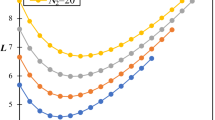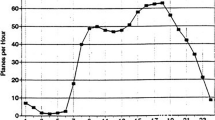Abstract
We analyze the queueing behavior of long-tailed traffic flows under the Generalized Processor Sharing (GPS) discipline. We show a sharp dichotomy in qualitative behavior, depending on the relative values of the weight parameters. For certain weight combinations, an individual flow with long-tailed traffic characteristics is effectively served at a constant rate. The effective service rate may be interpreted as the maximum average traffic rate for the flow to be stable, which is only influenced by the traffic characteristics of the other flows through their average rates. In particular, the flow is essentially immune from excessive activity of flows with ‘heavier’-tailed traffic characteristics. In many situations, the effective service rate is simply the link rate reduced by the aggregate average rate of the other flows. This confirms that GPS-based scheduling algorithms provide a potential mechanism for extracting significant multiplexing gains, while isolating individual flows. For other weight combinations however, a flow may be strongly affected by the activity of ‘heavier’-tailed flows, and may inherit their traffic characteristics, causing induced burstiness. The stark contrast in qualitative behavior illustrates the crucial importance of the weight parameters.
Similar content being viewed by others
References
J. Abate and W. Whitt, Asymptotics for M/G/1 low-priority waiting-time tail probabilities, Queueing Systems 25 (1997) 173–233.
R. Agrawal, A.M. Makowski and P. Nain, On a reduced load equivalence for fluid queues under subexponentiality, Queueing Systems 33 (1999) 5–41.
V. Anantharam, Scheduling strategies and long-range dependence, Queueing Systems 33 (1999) 73–89.
A. Arvidsson and P. Karlsson, On traffic models for TCP/IP, in: Teletraffic Engineering in a Competitive World, Proc. of ITC-16, Edinburgh, UK, eds. P. Key and D. Smith (North-Holland, Amsterdam, 1999) pp. 457–466.
V.E. Benes, General Stochastic Processes in the Theory of Queues (Addison-Wesley, Reading, MA, 1963).
J. Beran, R. Sherman, M.S. Taqqu and W. Willinger, Long-range dependence in variable-bit-rate video traffic, IEEE Trans. Commun. 43 (1995) 1566–1579.
D. Bertsimas, I.C. Paschalidis and J.N. Tsitsiklis, Large deviations analysis of the generalized processor sharing policy, Queueing Systems 32 (1999) 319–349.
N.H. Bingham, C.M. Goldie and J.L. Teugels, Regular Variation (Cambridge Univ. Press, Cambridge, UK, 1987).
S.C. Borst, O.J. Boxma and P.R. Jelenkovi?, Generalized processor sharing with long-tailed traffic sources, in: Teletraffic Engineering in a Competitive World, Proc. of ITC-16, Edinburgh, UK, eds. P. Key and D. Smith (North-Holland, Amsterdam, 1999) pp. 345–354.
S.C. Borst, O.J. Boxma and P.R. Jelenkovi?, Induced burstiness in generalized processor sharing queues with long-tailed traffic flows, in: Proc. of the 37th Annual Allerton Conf. on Communication, Control, and Computing, 1999, pp. 316–325.
S.C. Borst, O.J. Boxma and P.R. Jelenkovi?, Coupled processors with regularly varying service times, in: Proc. of Infocom 2000 Conference, Tel-Aviv, Israel, 2000, pp. 157–164.
S.C. Borst, O.J. Boxma and P.R. Jelenkovi?, Asymptotic behavior of generalized processor sharing with long-tailed traffic sources, in: Proc. of Infocom 2000 Conference, Tel-Aviv, Israel, 2000, pp. 912–921.
S.C. Borst, O.J. Boxma and P.R. Jelenkovi?, Reduced-load equivalence and induced burstiness in GPS queues with long-tailed traffic flows, CWI Report PNA-R0016 (2000), http://www.cwi.nl/ static/publications/reports/PNA-2000.html.
S.C. Borst, O.J. Boxma and M.J.G. van Uitert, Two coupled queues with heterogeneous traf-fic, in: Teletraffic Engineering in the Internet Era, Proc. of ITC-17, Salvador da Bahia, Brazil, eds. J. Moreira de Souza, N.L.S. Fonseca and E.A. de Souza e Silva (North-Holland, Amsterdam, 2001) pp. 1003–1014.
S.C. Borst, M. Mandjes and M.J.G. van Uitert, Generalized processor sharing queues with heterogeneous traffic classes, in: Proc. of Infocom 2002 Conference, New York, pp. 74–83.
O.J. Boxma, Fluid queues and regular variation, Performance Evaluation 27/28 (1996) 699–712.
O.J. Boxma, Regular variation in a multi-source fluid queue, in: Teletraffic Contributions for the Information Age, Proc. of ITC-15, Washington, eds. V. Ramaswami and P.E. Wirth (North-Holland, Amsterdam, 1997) pp. 391–402.
O.J. Boxma and J.W. Cohen, The single server queue: Heavy tails and heavy traffic, in: Self-similar Network Traffic and Performance Evaluation, eds. K. Park and W. Willinger (Wiley, New York, 2000) pp. 143–169.
O.J. Boxma, J.W. Cohen and Q. Deng, Heavy-traffic analysis of theM/G/1 queue with priority classes, in: Teletraffic Engineering in a Competitive World, Proc. of ITC-16, Edinburgh, UK, eds. P. Key and D. Smith (North-Holland, Amsterdam, 1999) pp. 1157–1167.
O.J. Boxma and V. Dumas, Fluid queues with heavy-tailed activity period distributions, Comput. Commun. 21 (1998) 1509–1529.
O.J. Boxma and V. Dumas, The busy period in the fluid queue, Performance Evaluation Rev. 26 (1998) 100–110.
G.L. Choudhury and W. Whitt, Long-tail buffer-content distributions in broadband networks, Performance Evaluation 30 (1997) 177–190.
D.B.H. Cline, Intermediate regular and ? variation, Proc. London Math. Soc. 68 (1994) 594–616.
J.W. Cohen, Some results on regular variation for distributions in queueing and fluctuation theory, J. Appl. Probab. 10 (1973) 343–353
M. Crovella and A. Bestavros, Self-similarity in World Wide Web traffic: Evidence and possible causes, in: Proc. of ACM Sigmetrics' 96, 1996, pp. 160–169.
P. Dupuis and K. Ramanan, A Skorokhod problem formulation and large deviation analysis of a processor sharing model, Queueing Systems 28 (1998) 109–124.
G. Fayolle, I. Mitrani and R. Iasnogorodski, Sharing a processor among many job classes, J. Assoc. Comput. Mach. 27 (1980) 519–532.
M. Grossglauser and J.-C. Bolot, On the relevance of long-range dependence in network traffic, IEEE/ACM Trans. Netw. 7 (1999) 629–640.
D.P. Heyman and T.V. Lakshman, Source models for VBR broadcast-video traffic, IEEE/ACMTrans. Netw. 4 (1996) 40–48.
P.R. Jelenkovi?, Asymptotic analysis of queues with subexponential arrival processes, in: Self-similar Network Traffic and Performance Evaluation, eds. K. Park and W. Willinger (Wiley, New York, 2000) pp. 249–268.
P.R. Jelenkovi? and A.A. Lazar, Asymptotic results for multiplexing subexponential on–off processes, Adv. in Appl. Probab. 31 (1999) 394–421.
W.E. Leland, M.S. Taqqu, W. Willinger and D.V. Wilson, On the self-similar nature of Ethernet traffic (extended version), IEEE/ACMTrans. Netw. 2 (1994) 1–15.
M. Mandjes and J.-H. Kim, Large deviations for small buffers: An insensitivity result, Queueing Systems (1999) to appear.
L. Massouli?, Large deviations estimates for polling and weighted fair queueing service systems, Adv. in Performance Anal. 37 (2001) 349–362.
A. De Meyer and J.L. Teugels, On the asymptotic behaviour of the distribution of the busy period and service time in M/G/1, J. Appl. Probab. 17 (1980) 802–813.
A.G. Pakes, On the tails of waiting-time distributions, J. Appl. Probab. 12 (1975) 555–564.
A.K. Parekh and R.G. Gallager, A generalized processor sharing approach to flow control in integrated services networks: The single-node case, IEEE/ACM Trans. Netw. 1 (1993) 344–357.
A.K. Parekh and R.G. Gallager, A generalized processor sharing approach to flow control in integrated services networks: The multiple node case, IEEE/ACM Trans. Netw. 2 (1994) 137–150.
A. Paxson and S. Floyd, Wide area traffic: the failure of Poisson modeling, IEEE/ACM Trans. Netw. 3 (1995) 226–244.
B. Ryu and A. Elwalid, The importance of long-range dependence of VBR video traffic in ATMtraffic engineering: Myths and realities, Comput. Commun. Rev. 13 (1996) 1017–1027.
M.J.G. van Uitert and S.C. Borst, A reduced-load equivalence for Generalised Processor Sharing networks with long-tailed input flows, Queueing Systems 41 (2002) 123–163; shortened version in: Proc. of Infocom 2001 Conference, Alaska, 2000, pp. 269–278.
N. Veraverbeke, Asymptotic behaviour of Wiener–Hopf factors of a random walk, Stochastic Processes Appl. 5 (1977) 27–37.
W. Willinger, M.S. Taqqu, R. Sherman and D.V. Wilson, Self-similarity through high-variability: Statistical analysis of Ethernet LAN traffic at the source level, IEEE/ACM Trans. Netw. 5 (1997) 71–86.
Z.-L. Zhang, Large deviations and the generalized processor sharing scheduling for a multiple-queue system, Queueing Systems 28 (1998) 349–376.
Z.-L. Zhang, D. Towsley and J. Kurose, Statistical analysis of the generalized processor sharing discipline, IEEE J. Selected Areas Commun. 13 (1995) 1071–1080.
A.P. Zwart, Private communication (1999).
A.P. Zwart, Sojourn times in a multiclass processor sharing queue, in: Teletraffic Engineering in a Competitive World, Proc. of ITC-16, Edinburgh, UK, eds. P. Key and D. Smith (North-Holland, Amsterdam, 1999) pp. 335–344.
A.P. Zwart, Tail asymptotics for the busy period in the GI/G/1 queue, Math. Oper. Res. 26 (2001) 475–483.
A.P. Zwart and O.J. Boxma, Sojourn time asymptotics in theM/G/1 processor sharing queue, Queueing Systems 35 (2000) 141–166.
Author information
Authors and Affiliations
Rights and permissions
About this article
Cite this article
Borst, S., Boxma, O. & Jelenković, P. Reduced-Load Equivalence and Induced Burstiness in GPS Queues with Long-Tailed Traffic Flows. Queueing Systems 43, 273–306 (2003). https://doi.org/10.1023/A:1023237129453
Issue Date:
DOI: https://doi.org/10.1023/A:1023237129453




